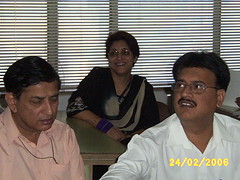We know how Meta-data has replaced the term "Indexing" and "Cataloguing" in the last decade. Now it is turn of "Key Words" to be replaced by a term called "tagging". The only difference in these two terms is that "Key Words" are picked up from some standard vocabulary like MeSH by professionals; "tagging" is done by end users to bookmark and categorize an internet resource without any rules or vocabulary. The intention is to retrieve the "tagged" resource in future. But there is a Method in this Madness of tagging. The user indirectly registers a "vote" in favor of the resource being tagged. Such votes when collected on a service provider end can be used to indicate relative popularity of various resources. Del.icio.us is one of such service. This collective behavior is known "collaborative tagging".
Macgregor, George and McCulloch, Emma in their pre-print [accepted for publication] has suggested that Librarians and information professional researchers should take a leading role in research aimed at assessing the efficacy of collaborative tagging in relation to information storage, organization, and retrieval, and to influence the future development of collaborative tagging systems.
I am myself a regular user of Del.icio.us . I can keep links to my favorite articles, blogs, sites etc. and can access them from any computer on the web. I can share them easily by just by giving its URL . Moreover I can check up who else have tagged a particular resource of my interest. Exploring further I can find out from other's tags what all other resources could be of my interest.
Does not this sound similar to "Pearl Growing" in Science Citation Index? Such collaborative tagging sites also present what is known as "Tag Cloud" showing relative importance of tags in terms size and colour of fonts.
So when will be the term "Key Words" replaced by "tags"?.
Macgregor, George and McCulloch, Emma in their pre-print [accepted for publication] has suggested that Librarians and information professional researchers should take a leading role in research aimed at assessing the efficacy of collaborative tagging in relation to information storage, organization, and retrieval, and to influence the future development of collaborative tagging systems.
I am myself a regular user of Del.icio.us . I can keep links to my favorite articles, blogs, sites etc. and can access them from any computer on the web. I can share them easily by just by giving its URL . Moreover I can check up who else have tagged a particular resource of my interest. Exploring further I can find out from other's tags what all other resources could be of my interest.
Does not this sound similar to "Pearl Growing" in Science Citation Index? Such collaborative tagging sites also present what is known as "Tag Cloud" showing relative importance of tags in terms size and colour of fonts.
So when will be the term "Key Words" replaced by "tags"?.
